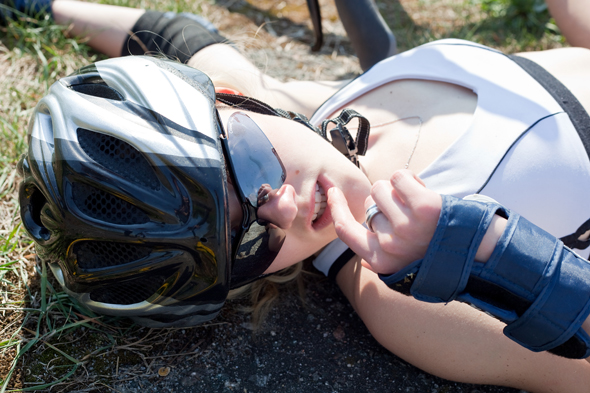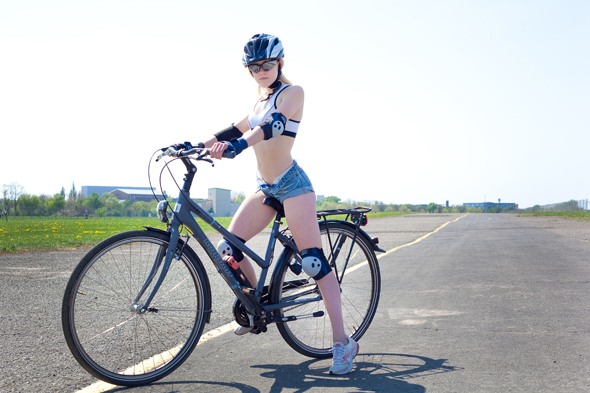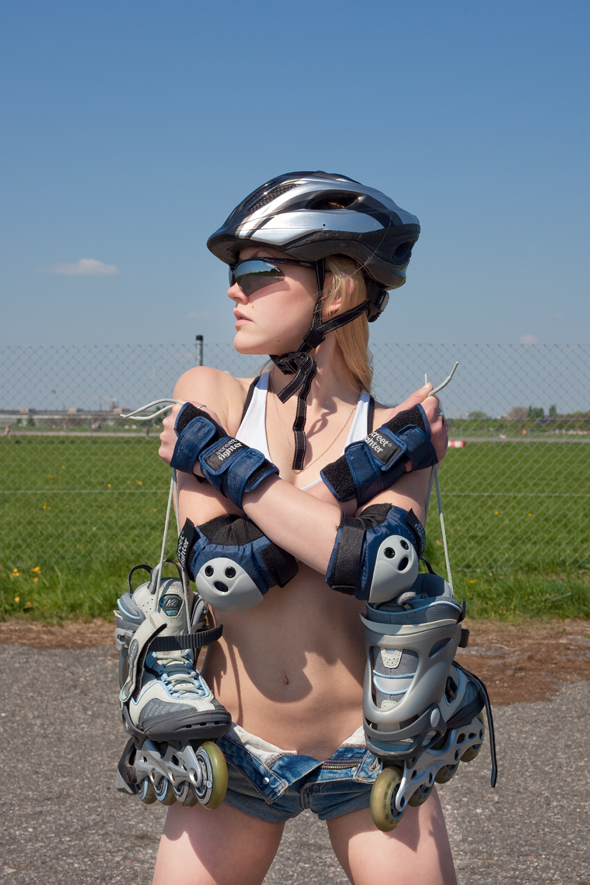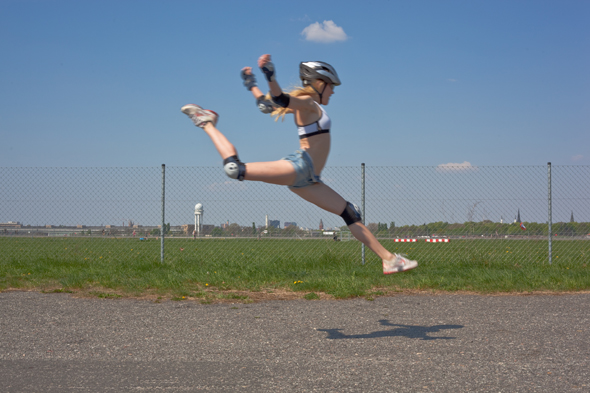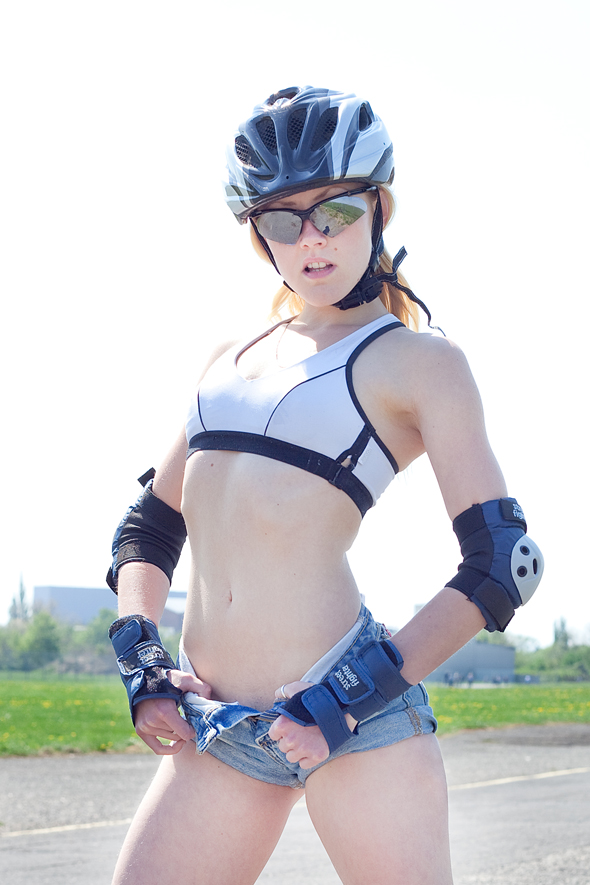by Corinna Kirsch, photos by Mike Milosh // May 30, 2011
Curator and writer Corinna Kirsch sat down with one of Berlin’s busiest and most intriguing dance and performance artists, Helga Wretman — also Germany’s tiniest stunt-double. The two discussed technology, decadence, spandex, and choreography on a recent afternoon in Neukölln. Wretman’s spring exhibitions include a performance which took place at The Grimmuseum on May 5, and an upcoming performance, “The Safety Protocol” on June 7, 2011 for BASED IN BERLIN. Wretman is pictured here in “Safety is Sexy”, a photographic series by Mike Milosh, which corresponds to her upcoming performance.
CORINNA KIRSCH: Tell me more about all the stunts that you do. It sounds exciting; it sounds dangerous. How did you learn to do this? Not all dancers and actresses have that background to be able to do stunts.
HELGA WRETMAN: First of all, I did a lot of dance and theatre projects where I had to get punched in the face, fall down the stairs, or get raped on stage. I came to this point in my life where I didn’t want to dance anymore and I thought that if I can do these things on stage, then I can do them in movies, too.
What types of stunts do you do?
It’s all body stunts; no driving. Bicycle, maybe; horse, maybe. It’s dangerous, if you don’t know what you’re doing. The thing is, you always have to know what you can do and what you can’t do. It’s rule number one for me. 95% of the job is making sure that it’s safe and then the actual stunt is sometimes two or three seconds long. It’s all about safety.
What art, choreography, or dance projects have you recently completed?
There’s too many! The last performance-related project that I did on my own was last winter in Zurich. At darsa comfort… [In Zurich], I was asked to do a performance about commerce. The first thing that comes to mind for me is commercials and always being exposed to products and the relationship that I have and very many people have with commercials. You see a billboard, but you don’t really think about it; it just goes into your subconscious. There’s so much of it everywhere that you don’t really recognize it anymore. And I don’t have a TV, so I’m thinking more about magazines or signs on the U-Bahn. There’s a non-relationship with commercials, but they’re still there.
Right. They’re always there whether or not you’re paying attention to them. They become embedded.
The second thing that came to mind because I’m working with the body a lot is the model and her relationship to the object; the model as the presenter, or face, and that person’s relationship to the product.
Right. There’s a reason why advertisements aren’t just the product. There has to be a person there showing how it can be used and how it can change your life.
There has to be something appealing—like sex. There has to be some smiling girl or a kid that confirms to the broader audience that this product is a good thing and that they will be happier if this thing is in their life. That relationship to the audience or the people receiving the advertisement is the other branch of what I wanted to focus on with that project. Then I built a screen out of spandex. Then I used products and “abstract things” to put behind the screen.
What type of abstract things?
Packaging, a piece of styrofoam, or something where you wouldn’t realize what it was. I would have people stand behind the screen and they would push the things out; spandex can stretch to 600 times its own size. They would take the object and just push it out as far as they could and then at some point it [the screen] would become a little bit see-through. With abstract things you could never guess what they were, but the of course there was a pack of Marlboro cigarettes, there was an iPhone, a camera, a Happy Meal box.
Juliette Bonneviot developed the music using samples from music that’s been developed for malls so that you would buy more. She took these samples and then we made a score for the performance. The song is going to be in the show at Grimmuseum and Juliette is going to make music with me for the based in berlin show, too.
With choreography, you’re the one who is in charge, but you’re also the one who is responsible for the product.
Of course. In the process of working with other people it’s important to encourage people and make them understand why it is that you want to do what you want them to do and make them be on the same page as you. It’s definitely different with artists because artists do their own thing, but I also know what it is to be working as the performer, dancer, or actor for someone else. A lot of choreographers say “How do you feel about this? Can you show me some stuff?” Me, no, I’m like “5, 6, 7, 8 and go!”
It’s hard, though, because I feel like with performance some people coming from an art background don’t realize that you still have to rehearse.
It’s so weird! I don’t understand. I need a month to prepare, there’s the whole set design, I need people to do camera, I need people to build stuff, to rehearse. Coming from dance, theatre, and film, it’s obvious.
What are you doing at Grimmuseum, then?
I’m doing something I haven’t done, but that I’ve done before [in Zurich]. It’s the continuation of that performance and I’m bringing it to another level. I feel like the one I did in Zurich was the two-dimensional version of this performance. It’s going to be a little more abstract than the other one. I’m not going to perform in it myself. The same thing with based in berlin;. I want to have people perform it for me. It’s much easier for me to conduct things then, but lot of curators say, “You should be in it!”
But there’s so much of a history of choreographers that have done similar things like Merce Cunningham! But no one would have chided him, saying “Oh, you’re not dancing in this one?” You’re just rare and in a rare field. From doing this [dancing] for so many years, you probably have a hypersensitivity to how things should look in space. You can just visualize everything.
Exactly. And I don’t have to stand there and imagine how would it look like from the audience’s point of view. There’s something special and fragile about that. If there’s one person in the performance it’s me, but if there’s many, I would rather have other people do it. The theme for the based in berlin project tampers with that, too. The subject is “safety”. It’s difficult to translate into something performative because if you talk about safety then you have to have danger.
It’s like any sort of black-and-white term, where in order to define something as safe you have to know about it’s opposite.
When I started as a stunt-person I was thinking that I wanted to burn on stage and do all this stunt-related stuff in my work. But now I think the safety part of my job and being the “double” are more interesting than getting punched in the face—and the fakeness! That Nothing is for real is interesting aspect for me in my art practice.
Safety seems like something that you deal with on a fairly regular basis: these issues of safety in terms of doing stunts become part of your art practice. For me, one reason why I’m interested in technology and how it relates to our communication with others in art is because we use it everyday; I’m behind my laptop for hours everyday whether or not I like it.
I’m interested in that stuff, too; things are changing all the time. We’re in a period of human life where things are changing so much because of technology. Every year our life has a new update. We adapt to these things and they change our lives.
How do you with — for instance, the safety project for based in berlin—start a project? What’s your process?
I collect ideas and then envision them as something. I always realize that they’re impossible and fantastic.
I like that idea; to imagine something as much larger than what can be accomplished.
That’s always what I do. It’s like shooting for the stars, imagining the most amazing thing I would want to see and then I scale it down to what is possible.
Tell me more about “Fitness for Artists.”
FFA started out as something I did for fun because so many people asked me about staying fit and what they could do and teach them all these exercises. Then I started teaching it in the park in the summer. I’ve been developing a series of exercises that I would take from different sports. My intention was to make a mix of a lot of very different things so that the people could find something within the exercise that they could then continue, be interested in, and then work on.
It starts with dance to warm-up the body and soften the joints, and then goes into aerobics, very high-pulse warm-up things; and then we do sparring and self-defense; and then there’s jumpstyle tutorial. Then it’s yoga strength training and stretching. As I started doing it I saw all these links between artists doing things together that were more physical, artists fighting each other, and different sections of the class became very symbolic.
I think that even just that there was the desire, that there was a space for an “exercise for artists” class [is symbolic]. It may not have existed before you did it, but the fact is that people wanted that.
There’s also the fact that ever since I was old enough to see what was going on around me, growing up in the art world, I realized that the art world is very, very decadent and people live a decadent lifestyle. Not in terms of money, but how they eat, how they drink, how they treat themselves.
I also feel like they’re [decadence and exercise] connected in that they’re both extreme behaviors. In one sense, you have a lot of control over your body just to say, for instance, “I can run such-and-such number of kilometers even if my body is telling me not to, I’m going to continue going.” There’s still that relationship with being in control and losing control. I don’t think exercise is far off from thinking about, for instance, performance art, and how so much of it is endurance-based in relationship to the body.
I think right now there’s a change and there’s a will not to glorify this party side as much, but people will always want to lose control.
The next step of this project will be presented by DUVE Berlin. I’m going to invite artists from different parts of the world to join over Tiny Chat while I’m going to teach the course online. I’m going to encourage them to work out in the studio so that their work will be present in the exercise session. I’ve taught the class in a lot of art contexts and in galleries, but I’ve never had video documentation before.
Additional Info
Performance Info
Based in Berlin – Atelierhaus Monbijoupark
The Safety Protocol: June 7, 2011, 10pm
basedinberlin.de
Writer Info
Corinna Kirsch is a curator and writer. Her writing has been featured in Art Papers, Motherwell Journal, Art Fag City, and other print and online publications. She was awarded the 2010 C Magazine New Critics Prize for art criticism. Recently, she finished writing catalog essays for the Artishok Biennial held in Tartu, Estonia and she spoke on an art criticism panel at Nuit Blanche in Toronto. She blogs at Here is a Fantasy, an online collection of things resembling contemporary art. Her Master of Arts thesis is “Early Video Art: From Anti-TV to Anti-Eye,” written in completion of her Master of Arts degree in Art History.


